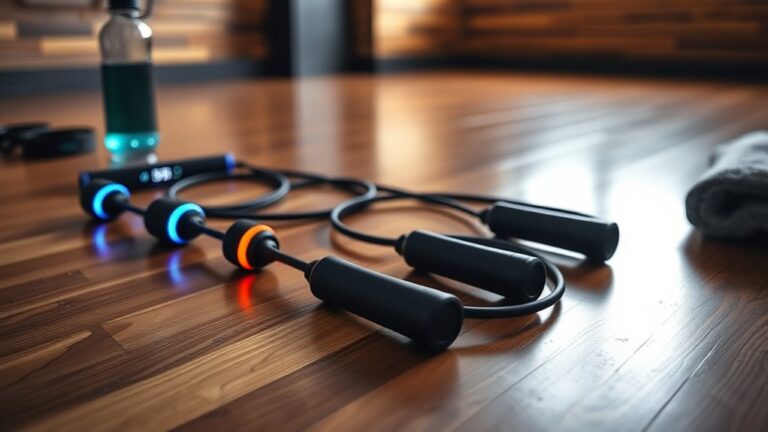How to Train for a Marathon Using Gym Equipment

To train for a marathon using gym equipment, focus on a mix of strength training and cardio. Incorporate machines like leg presses and squat machines to build lower body strength, and use core stability exercises to enhance endurance. Utilize treadmills for speed intervals and stationary bikes for cross-training. Don’t forget to stretch with foam rollers for recovery. This balanced approach not only boosts performance but also minimizes injury risks. There’s more to explore that can enhance your training journey.
The Importance of Strength Training for Runners

Why is strength training essential for runners? It’s important because it enhances your running performance and minimizes your risk of injuries. Engaging in strength training benefits your muscles, helping them support your joints better and absorb the impact of each stride. This is particularly significant for runners, as strong muscles can prevent common injuries like shin splints and runner’s knee. Incorporating exercises like the Turkish Get Up, which focuses on core stability, can further enhance your strength training routine.
Incorporating injury prevention strategies into your routine can be as simple as focusing on core stability and leg strength. Exercises like squats and lunges not only build muscle but also improve your balance and coordination. By developing these areas, you’ll create a more resilient body that can withstand the rigors of marathon training.
Essential Gym Equipment for Marathon Training
When it comes to marathon training, having the right gym equipment can make all the difference in your preparation. A treadmill is essential for your treadmill workouts, allowing you to simulate race conditions while controlling speed and incline. This helps build endurance in a safe environment, especially during inclement weather.
Having the right gym equipment, like a treadmill, is crucial for effective marathon training and endurance building.
In addition to a treadmill, consider incorporating a stationary bike for cross-training. It’s low-impact, reducing stress on your joints while still enhancing cardiovascular fitness.
Resistance bands are another valuable tool for improving flexibility and strength without heavy weights. They’re easy to use and can be adjusted to suit your fitness level.
Lastly, don’t forget about proper gym safety. Always confirm equipment is in good condition and familiarize yourself with its use. This will not only protect you from injury but also enhance your overall training experience. With the right tools, you’ll be well on your way to marathon success.
Building Lower Body Strength With Machines

To effectively build lower body strength for marathon training, incorporating gym machines can be incredibly beneficial. Focus on machine workouts that target key muscle groups safely and efficiently. Here are some exercises to include in your routine:
- Leg Press: This targets your quads, hamstrings, and glutes while allowing you to control the weight.
- Squat Machine: Perfect for enhancing quad strength and maintaining proper form during squats.
- Hamstring Curls: These help develop the muscles at the back of your thighs, essential for balance and stability.
Additionally, consider incorporating calf raises, leg extensions, glute bridges, and exercises on the hip abductor. Resistance machines offer a safe environment to build strength without compromising form. Remember to adjust the weights according to your fitness level and always prioritize safety to avoid injury. With consistent effort on these machines, you’ll enhance your lower body strength for marathon success.
Enhancing Core Stability for Endurance
Although many runners focus primarily on legs for marathon training, enhancing core stability is equally essential for endurance. A strong core helps maintain proper posture and reduces the risk of injury during long runs. Incorporating core stability exercises into your routine can greatly boost your performance.
Start with exercises like planks, Russian twists, and stability ball rollouts. These movements engage your abdominal muscles, lower back, and pelvic region, providing a solid foundation for your legs. Additionally, consider using gym equipment like medicine balls or stability discs to increase the challenge safely.
Pair these core exercises with endurance training techniques, such as interval running or tempo runs, to create a balanced workout regimen. Remember, a strong core means better control and efficiency when you’re out on the marathon course, enabling you to go the distance with confidence.
Utilizing Free Weights for Improved Performance

Incorporating free weights into your marathon training can greatly boost your performance. By strengthening your core muscles and enhancing leg power, you’ll improve your overall stability and balance. This added strength not only supports your running form but also helps prevent injuries along the way.
Strengthening Core Muscles
When you strengthen your core muscles, you’re not only enhancing your stability but also boosting your overall running performance. Incorporating core exercises using free weights can greatly improve your stability training, helping prevent injuries. Here are some effective exercises to include in your routine:
- Plank with Dumbbells: Engage your core while holding a plank position and lifting dumbbells.
- Russian Twists: Sit on the ground, lean back slightly, and twist your torso while holding a weight.
- Deadlifts: Focus on proper form to engage your core as you lift.
Always prioritize safety; start with lighter weights to master your form before increasing resistance. A strong core not only supports your runs but enhances your endurance and efficiency, making those marathon goals more achievable.
Enhancing Leg Power
To run a successful marathon, developing leg power is vital, and using free weights can greatly enhance your performance. Start by incorporating exercises like squats and lunges into your routine; these build strength and power in your legs. Combine them with sprint drills to improve your speed and explosive strength. When you’re ready, add plyometric exercises, such as box jumps or jump squats, to your regimen. These will help you develop the fast-twitch muscle fibers essential for a strong finish. Always focus on proper form to prevent injuries, and consider starting with lighter weights to guarantee your technique is solid. Gradually increase the weight as you gain strength, assuring you stay safe while pushing your limits.
Improving Stability and Balance
Building leg power is just one aspect of marathon training; improving stability and balance is equally important for overall performance. Incorporating free weights into your routine can enhance these skills, helping you stay injury-free on race day.
Try these effective stability exercises and balance drills:
- Single-leg deadlifts: This strengthens your hamstrings while promoting balance.
- Dumbbell overhead presses: Engaging your core, this exercise helps improve stability.
- Weighted side lunges: This targets your legs and enhances lateral balance.
Focus on controlled movements and proper form to guarantee safety. Gradually increase weight as your strength builds, and always listen to your body. By including these exercises, you’ll enhance your overall performance and confidence for marathon day.
Incorporating Resistance Bands Into Your Routine
As you gear up for marathon training, incorporating resistance bands into your routine can enhance your strength and stability. These versatile tools offer a range of resistance band exercises that target key muscle groups, helping you build the strength necessary for long-distance running. By integrating resistance bands, you can improve your core stability and leg strength without the risk of injury often associated with heavier weights.
Resistance band benefits include their ability to provide controlled resistance, allowing for safer movements and a lower chance of strain. You can perform exercises like squats, lateral band walks, and glute bridges to strengthen your hips and legs. Start with lighter bands to guarantee proper form, gradually increasing resistance as you become more comfortable. This approach not only builds strength but also enhances your overall running efficiency, making your marathon training safer and more effective.
The Role of Cardio Machines in Marathon Prep
While outdoor running is vital for marathon training, utilizing cardio machines can greatly enhance your preparation by providing a controlled environment to build endurance and stamina. Here’s how you can effectively incorporate them into your routine:
- Treadmill Intervals: Use this machine to mix high-intensity bursts with recovery periods. This helps improve your speed and cardiovascular fitness while reducing the risk of injury that outdoor running might pose.
- Elliptical Endurance: The elliptical is great for longer sessions without the impact stress on your joints. It mimics running while offering a low-impact alternative, allowing you to build stamina safely.
- Heart Rate Monitoring: Many cardio machines come with heart rate monitors. Keep track of your heart rate to verify you’re training in the right zone, which is essential for marathon prep.
Stretching and Recovery Tools for Runners
After incorporating cardio machines into your training, focusing on stretching and recovery can greatly enhance your performance and prevent injuries. One effective method is dynamic stretching, which warms up your muscles and increases flexibility before your workout. Try leg swings or arm circles to get your body ready for the run.
Post-run, don’t skip foam rolling. This tool helps release muscle tightness and improves blood flow, making recovery smoother. Spend a few minutes rolling out your calves, quads, and hamstrings to alleviate tension and prevent soreness.
Incorporating both dynamic stretching and foam rolling into your routine not only prepares your body for the demands of marathon training but also aids in quicker recovery. Remember, prioritizing these practices will keep you safe, allowing you to train consistently and effectively. Listen to your body, and make these tools an essential part of your marathon preparation.
Designing a Balanced Training Program
To design a balanced training program for your marathon, it’s crucial to incorporate a mix of long runs, speed work, and strength training. This not only helps build endurance but also enhances your overall performance while minimizing injury risk. By adding workout variety, you’ll keep things interesting and engage different muscle groups. Here are some key components to take into account:
- Long Runs: Aim for one long run each week to build stamina.
- Speed Work: Incorporate interval training or tempo runs to improve your pace.
- Strength Training: Focus on core and leg workouts to support your running form.
Don’t forget the cross training benefits; activities like cycling or swimming can enhance cardiovascular fitness and reduce impact on your joints. A well-rounded program guarantees you’re prepared for race day while maintaining your safety and health throughout your training journey. Additionally, consider promoting healthy habits to further support your training and overall fitness goals.
Tracking Progress and Making Adjustments
To reach your marathon goals, it’s essential to set clear objectives and regularly monitor your performance metrics. Keep an eye on your progress to see what’s working and what isn’t. Adjusting your workout plans based on this data will help you stay on track and improve your training efficiency.
Goal Setting Techniques
Setting clear goals is essential for your marathon training, as it not only keeps you motivated but also helps you track your progress effectively. Using SMART goals can guide your training approach, making it specific, measurable, achievable, relevant, and time-bound. Additionally, visualizing success can enhance your focus and commitment.
Consider these techniques for effective goal setting:
- Break down your marathon into smaller milestones to celebrate progress.
- Regularly reassess your goals, adjusting them as needed based on your performance and recovery.
- Keep a training journal to document your workouts and feelings, which helps in identifying patterns.
Monitoring Performance Metrics
While pursuing your marathon goals, monitoring performance metrics becomes essential for tracking progress and making necessary adjustments. Using gym equipment, you can access various performance analytics, such as heart rate, pace, and distance covered. These metrics provide valuable insights into your fitness levels and help you gauge your training effectiveness.
Regularly recording and reviewing this data allows for better data interpretation, ensuring you stay within safe training thresholds. For instance, if your heart rate spikes unexpectedly, it might indicate fatigue or overtraining. By keeping an eye on these performance metrics, you can make informed decisions about your workouts, helping you remain safe while progressing toward your marathon goals. Stay vigilant, and your dedication will pay off!
Adjusting Workout Plans
Monitoring your performance metrics provides a solid foundation for adjusting your workout plans effectively. As you progress, it’s essential to customize your schedules and evaluate intensity to guarantee you’re training safely and efficiently. Here are some ways to adjust your plans:
- Reassess your goals: Check if your initial goals still align with your progress and make changes if needed.
- Modify workout duration: Increase or decrease your sessions based on how your body feels.
- Alter intensity levels: Make sure that your workouts challenge you without risking injury.
Frequently Asked Questions
How Often Should I Train With Gym Equipment for Marathon Prep?
You might think that training too often could lead to injury, but a well-structured gym schedule can actually enhance your marathon prep. Aim for 3-4 sessions a week, focusing on strength, endurance, and flexibility. This training frequency allows your body to recover while building the muscle you need for those long runs. Be sure to listen to your body, and adjust as necessary to keep your training safe and effective.
Can I Substitute Running With Gym Equipment Workouts?
Yes, you can substitute running with gym equipment workouts. Treadmills offer benefits like controlled pacing and incline settings, which can mimic outdoor conditions. If you want an alternative, the elliptical is great for low-impact cardio, reducing stress on your joints while still providing a solid workout. Just be certain to maintain proper form and gradually increase intensity to guarantee safety and effectiveness in your training.
What Nutrition Should Accompany My Gym Training?
Nutrition’s the fuel that powers your engine, so don’t overlook it! For gym training, focus on balanced pre-race meals rich in carbs and protein to support your energy levels. Incorporate hydration strategies to guarantee you’re well-hydrated before, during, and after workouts. Aim for at least 8-10 cups of water daily, adjusting based on your activity level. Remember, fueling your body properly will keep you safe and performing at your best!
How Do I Avoid Injuries While Training in the Gym?
To avoid injuries while training in the gym, focus on injury prevention by prioritizing proper form in every exercise. It’s essential to start with lighter weights to master your technique before increasing the load. Make sure to warm up and cool down adequately, and listen to your body; if something feels off, don’t push through the pain. Incorporate rest days to allow your muscles to recover, ensuring a safer training experience overall.
Should I Focus More on Cardio or Strength Training for Marathons?
When training for a marathon, it’s important to balance cardio and strength. Cardio benefits your endurance, helping you build stamina for those long runs. However, strength advantages shouldn’t be overlooked, as they support your joints and improve running efficiency. You’ll want to incorporate both types of training into your routine to stay safe and avoid injuries. So, mix in some weight training with your cardio workouts for the best results!





